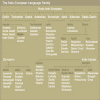
Relationships between languages
by Sep Meyer
Having read the somewhat tongue-in-cheek article about Finnish and the possibility of a special relationship with the Czech language, I felt it would be appropriate to give a summary of the precise relationship between them.
In fact, the short answer is that there is none.
Here is a chart of the relationships between the various languages in the Indo-European Language Family [Left click on it to see it full size]:
It will be noted that whereas Czech is in the fairly logical group of Balto-Slavic tongues, alongside the equally logical Latvian, Lithuanian, Bulgarian, Serbo-Croat, Russian, etc. there are some apparently illogical omissions.
These include Finnish, Hungarian and Estonian. The reason for this is that these three share their linguistic origins within the Ural-Altaic family of tongues. Even more surprisingly is that this group includes Japanese and Mongol. The only explanation I have ever heard for this peculiarity is that they all derived from people living to the east of the Urals who, many centuries ago, migrated in two directions. One group, moving eastwards, eventually settled in Mongolia and Japan. The other, moving westwards, split again, half settling in the Magyar region and half in Finland/Estonia.
Although it does appears surprising, at first glance, all these languages do share the same mellifluous preponderance of vowels.